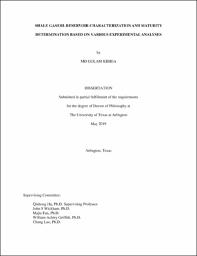
ATTENTION: The works hosted here are being migrated to a new repository that will consolidate resources, improve discoverability, and better show UTA's research impact on the global community. We will update authors as the migration progresses. Please see MavMatrix for more information.
Show simple item record
| dc.contributor.advisor | Hu, Qinhong | |
| dc.creator | Kibria, Md Golam | |
| dc.date.accessioned | 2019-06-13T17:53:29Z | |
| dc.date.available | 2019-06-13T17:53:29Z | |
| dc.date.created | 2019-05 | |
| dc.date.issued | 2019-05-31 | |
| dc.date.submitted | May 2019 | |
| dc.identifier.uri | http://hdl.handle.net/10106/28213 | |
| dc.description.abstract | Despite the successful shale hydrocarbon exploration and production in the U.S. started about 20 years ago, the producing wells experience a current low total recovery of tight oil (5%-10%) and shale gas (12%-30%). One of the critical obstacles to sustainable shale development is related to the low recovery factor, which still needs much investigation. Hydrocarbon movement through shale reservoirs is controlled by two factors related to pore structure: one is pore size distribution (geometry), and another one is pore connectivity (topology). This Ph.D. research is divided into three different projects: 1) The 1st one is to improve the understanding of shale reservoir nanopore structure and wettability characteristics of Woodford Shale. For this research I examine mineralogy, pore structure, wetting characteristics, imbibition behavior, and edge-accessible porosity with the following complementary tests: X-ray diffraction (XRD), mercury injection capillary pressure (MICP), contact angle measurement of various fluids, fluid imbibition into initially dry shale, and edge-accessible pore connectivity from vacuum saturation-high pressure impregnation with tracers-containing n-decane. The wettability and imbibition tests use both hydrophilic (DI water) and hydrophobic (n-decane) fluids; 2) the second research is to use Laser Raman spectra of kerogens, G (graphitic) and D (disordered) bands of disordered carbonaceous matter, to relate the thermal maturity of representative shale oil samples, with the intention of establishing an empirical equation to determine thermal maturity directly using Laser Raman spectra with minimal sample preparation for potential ‘on rig’ use including the down-hole environment; 3) The third and last research is to investigate two different shale plays Haynesville and Pearsall Shale for an improved understanding of their petrophysical properties based on various experimental analyses. Overall, this dissertation will help to understand nanopore structure and wettability characteristics of unconventional shale, their nanopore structure characteristics and fluid flow behavior and establishing a method to determine thermal maturity directly using Laser Raman spectra. | |
| dc.format.mimetype | application/pdf | |
| dc.language.iso | en_US | |
| dc.subject | Shale gas | |
| dc.subject | Reservoir | |
| dc.subject | Reservoir characterization | |
| dc.subject | Pore network | |
| dc.subject | Raman spectroscopy | |
| dc.subject | Shale maturity | |
| dc.title | SHALE GAS/OIL RESERVOIR CHARACTERIZATION AND MATURITY DETERMINATION BASED ON VARIOUS EXPERIMENTAL ANALYSES | |
| dc.type | Thesis | |
| dc.degree.department | Earth and Environmental Sciences | |
| dc.degree.name | Doctor of Philosophy in Earth and Environmental Science | |
| dc.date.updated | 2019-06-13T17:53:45Z | |
| thesis.degree.department | Earth and Environmental Sciences | |
| thesis.degree.grantor | The University of Texas at Arlington | |
| thesis.degree.level | Doctoral | |
| thesis.degree.name | Doctor of Philosophy in Earth and Environmental Science | |
| dc.type.material | text | |
Files in this item
- Name:
- KIBRIA-DISSERTATION-2019.pdf
- Size:
- 5.668Mb
- Format:
- PDF
This item appears in the following Collection(s)
Show simple item record


